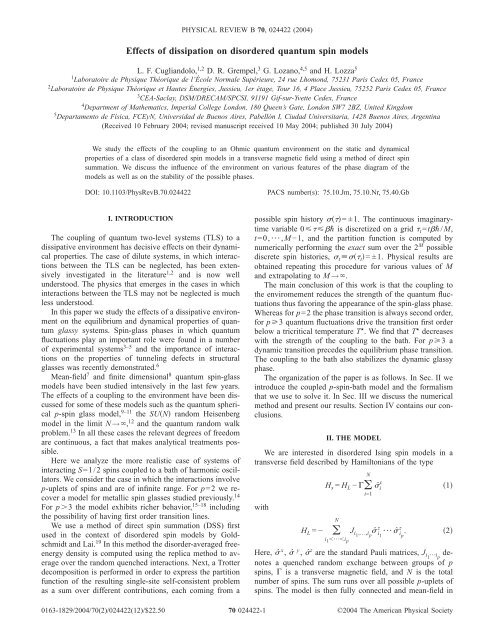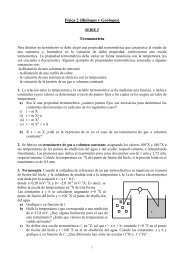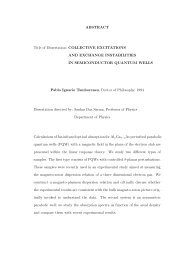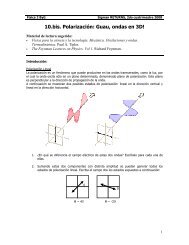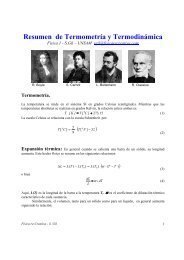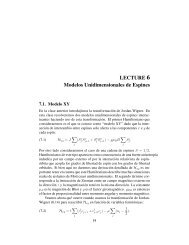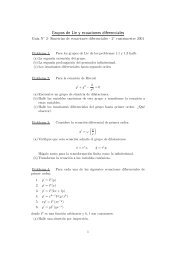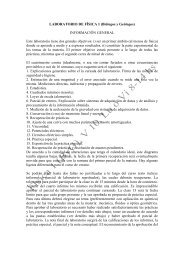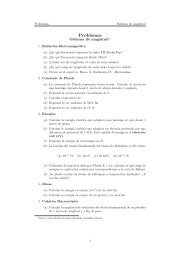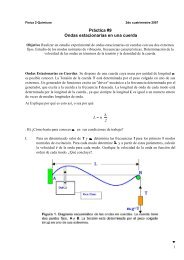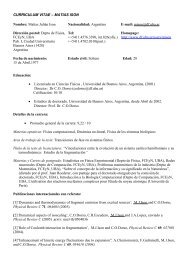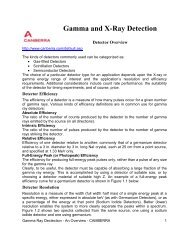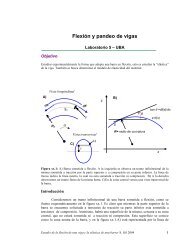Effects of dissipation on disordered quantum spin models - APS Link ...
Effects of dissipation on disordered quantum spin models - APS Link ...
Effects of dissipation on disordered quantum spin models - APS Link ...
You also want an ePaper? Increase the reach of your titles
YUMPU automatically turns print PDFs into web optimized ePapers that Google loves.
PHYSICAL REVIEW B 70, 024422 (2004)<str<strong>on</strong>g>Effects</str<strong>on</strong>g> <str<strong>on</strong>g>of</str<strong>on</strong>g> <str<strong>on</strong>g>dissipati<strong>on</strong></str<strong>on</strong>g> <strong>on</strong> <strong>disordered</strong> <strong>quantum</strong> <strong>spin</strong> <strong>models</strong>L. F. Cugliandolo, 1,2 D. R. Grempel, 3 G. Lozano, 4,5 and H. Lozza 51 Laboratoire de Physique Théorique de l’École Normale Supérieure, 24 rue Lhom<strong>on</strong>d, 75231 Paris Cedex 05, France2 Laboratoire de Physique Théorique et Hautes Énergies, Jussieu, 1er étage, Tour 16, 4 Place Jussieu, 75252 Paris Cedex 05, France3 CEA-Saclay, DSM/DRECAM/SPCSI, 91191 Gif-sur-Yvette Cedex, France4 Department <str<strong>on</strong>g>of</str<strong>on</strong>g> Mathematics, Imperial College L<strong>on</strong>d<strong>on</strong>, 180 Queen’s Gate, L<strong>on</strong>d<strong>on</strong> SW7 2BZ, United Kingdom5 Departamento de Física, FCEyN, Universidad de Buenos Aires, Pabellón I, Ciudad Universitaria, 1428 Buenos Aires, Argentina(Received 10 February 2004; revised manuscript received 10 May 2004; published 30 July 2004)We study the effects <str<strong>on</strong>g>of</str<strong>on</strong>g> the coupling to an Ohmic <strong>quantum</strong> envir<strong>on</strong>ment <strong>on</strong> the static and dynamicalproperties <str<strong>on</strong>g>of</str<strong>on</strong>g> a class <str<strong>on</strong>g>of</str<strong>on</strong>g> <strong>disordered</strong> <strong>spin</strong> <strong>models</strong> in a transverse magnetic field using a method <str<strong>on</strong>g>of</str<strong>on</strong>g> direct <strong>spin</strong>summati<strong>on</strong>. We discuss the influence <str<strong>on</strong>g>of</str<strong>on</strong>g> the envir<strong>on</strong>ment <strong>on</strong> various features <str<strong>on</strong>g>of</str<strong>on</strong>g> the phase diagram <str<strong>on</strong>g>of</str<strong>on</strong>g> the<strong>models</strong> as well as <strong>on</strong> the stability <str<strong>on</strong>g>of</str<strong>on</strong>g> the possible phases.DOI: 10.1103/PhysRevB.70.024422PACS number(s): 75.10.Jm, 75.10.Nr, 75.40.GbI. INTRODUCTIONThe coupling <str<strong>on</strong>g>of</str<strong>on</strong>g> <strong>quantum</strong> two-level systems (TLS) to adissipative envir<strong>on</strong>ment has decisive effects <strong>on</strong> their dynamicalproperties. The case <str<strong>on</strong>g>of</str<strong>on</strong>g> dilute systems, in which interacti<strong>on</strong>sbetween the TLS can be neglected, has been extensivelyinvestigated in the literature 1,2 and is now wellunderstood. The physics that emerges in the cases in whichinteracti<strong>on</strong>s between the TLS may not be neglected is muchless understood.In this paper we study the effects <str<strong>on</strong>g>of</str<strong>on</strong>g> a dissipative envir<strong>on</strong>ment<strong>on</strong> the equilibrium and dynamical properties <str<strong>on</strong>g>of</str<strong>on</strong>g> <strong>quantum</strong>glassy systems. Spin-glass phases in which <strong>quantum</strong>fluctuati<strong>on</strong>s play an important role were found in a number<str<strong>on</strong>g>of</str<strong>on</strong>g> experimental systems 3–5 and the importance <str<strong>on</strong>g>of</str<strong>on</strong>g> interacti<strong>on</strong>s<strong>on</strong> the properties <str<strong>on</strong>g>of</str<strong>on</strong>g> tunneling defects in structuralglasses was recently dem<strong>on</strong>strated. 6Mean-field 7 and finite dimensi<strong>on</strong>al 8 <strong>quantum</strong> <strong>spin</strong>-glass<strong>models</strong> have been studied intensively in the last few years.The effects <str<strong>on</strong>g>of</str<strong>on</strong>g> a coupling to the envir<strong>on</strong>ment have been discussedfor some <str<strong>on</strong>g>of</str<strong>on</strong>g> these <strong>models</strong> such as the <strong>quantum</strong> sphericalp-<strong>spin</strong> glass model, 9–11 the SUN random Heisenbergmodel in the limit N→, 12 and the <strong>quantum</strong> random walkproblem. 13 In all these cases the relevant degrees <str<strong>on</strong>g>of</str<strong>on</strong>g> freedomare c<strong>on</strong>tinuous, a fact that makes analytical treatments possible.Here we analyze the more realistic case <str<strong>on</strong>g>of</str<strong>on</strong>g> systems <str<strong>on</strong>g>of</str<strong>on</strong>g>interacting S=1/2 <strong>spin</strong>s coupled to a bath <str<strong>on</strong>g>of</str<strong>on</strong>g> harm<strong>on</strong>ic oscillators.We c<strong>on</strong>sider the case in which the interacti<strong>on</strong>s involvep-uplets <str<strong>on</strong>g>of</str<strong>on</strong>g> <strong>spin</strong>s and are <str<strong>on</strong>g>of</str<strong>on</strong>g> infinite range. For p=2 we recovera model for metallic <strong>spin</strong> glasses studied previously. 14For p3 the model exhibits richer behavior, 15–18 includingthe possibility <str<strong>on</strong>g>of</str<strong>on</strong>g> having first order transiti<strong>on</strong> lines.We use a method <str<strong>on</strong>g>of</str<strong>on</strong>g> direct <strong>spin</strong> summati<strong>on</strong> (DSS) firstused in the c<strong>on</strong>text <str<strong>on</strong>g>of</str<strong>on</strong>g> <strong>disordered</strong> <strong>spin</strong> <strong>models</strong> by Goldschmidtand Lai. 19 In this method the disorder-averaged freeenergydensity is computed using the replica method to averageover the random quenched interacti<strong>on</strong>s. Next, a Trotterdecompositi<strong>on</strong> is performed in order to express the partiti<strong>on</strong>functi<strong>on</strong> <str<strong>on</strong>g>of</str<strong>on</strong>g> the resulting single-site self-c<strong>on</strong>sistent problemas a sum over different c<strong>on</strong>tributi<strong>on</strong>s, each coming from apossible <strong>spin</strong> history = ±1. The c<strong>on</strong>tinuous imaginarytimevariable 0 is discretized <strong>on</strong> a grid t =t/M,t=0,¯ ,M −1, and the partiti<strong>on</strong> functi<strong>on</strong> is computed bynumerically performing the exact sum over the 2 M possiblediscrete <strong>spin</strong> histories, t t = ±1. Physical results areobtained repeating this procedure for various values <str<strong>on</strong>g>of</str<strong>on</strong>g> Mand extrapolating to M →.The main c<strong>on</strong>clusi<strong>on</strong> <str<strong>on</strong>g>of</str<strong>on</strong>g> this work is that the coupling tothe enviromement reduces the strength <str<strong>on</strong>g>of</str<strong>on</strong>g> the <strong>quantum</strong> fluctuati<strong>on</strong>sthus favoring the appearance <str<strong>on</strong>g>of</str<strong>on</strong>g> the <strong>spin</strong>-glass phase.Whereas for p=2 the phase transiti<strong>on</strong> is always sec<strong>on</strong>d order,for p3 <strong>quantum</strong> fluctuati<strong>on</strong>s drive the transiti<strong>on</strong> first orderbelow a tricritical temperature T . We find that T decreaseswith the strength <str<strong>on</strong>g>of</str<strong>on</strong>g> the coupling to the bath. For p3 adynamic transiti<strong>on</strong> precedes the equilibrium phase transiti<strong>on</strong>.The coupling to the bath also stabilizes the dynamic glassyphase.The organizati<strong>on</strong> <str<strong>on</strong>g>of</str<strong>on</strong>g> the paper is as follows. In Sec. II weintroduce the coupled p-<strong>spin</strong>-bath model and the formalismthat we use to solve it. In Sec. III we discuss the numericalmethod and present our results. Secti<strong>on</strong> IV c<strong>on</strong>tains our c<strong>on</strong>clusi<strong>on</strong>s.II. THE MODELWe are interested in <strong>disordered</strong> Ising <strong>spin</strong> <strong>models</strong> in atransverse field described by Hamilt<strong>on</strong>ians <str<strong>on</strong>g>of</str<strong>on</strong>g> the typeNH s = H L − ˆ ix1i=1withH L =−Ni 1 ¯i pJ i1 ,...,i pˆ z i1¯ ˆ z ip.Here, ˆ x, ˆ y, ˆ z are the standard Pauli matrices, J i1¯i pdenotesa quenched random exchange between groups <str<strong>on</strong>g>of</str<strong>on</strong>g> p<strong>spin</strong>s, is a transverse magnetic field, and N is the totalnumber <str<strong>on</strong>g>of</str<strong>on</strong>g> <strong>spin</strong>s. The sum runs over all possible p-uplets <str<strong>on</strong>g>of</str<strong>on</strong>g><strong>spin</strong>s. The model is then fully c<strong>on</strong>nected and mean-field in20163-1829/2004/70(2)/024422(12)/$22.50 70 024422-1©2004 The American Physical Society
CUGLIANDOLO, GREMPEL, LOZANO, AND LOZZA PHYSICAL REVIEW B 70, 024422 (2004)character. The transverse field introduces <strong>quantum</strong> fluctuati<strong>on</strong>sin what would otherwise be a purely classical model.To completely define the model we must choose p and thedistributi<strong>on</strong> PJ <str<strong>on</strong>g>of</str<strong>on</strong>g> random interacti<strong>on</strong>s. We c<strong>on</strong>sider thecase in which the random independent variables J i1 ,...,i pareGaussian with zero mean and variance p!J 2 /2N p−1 . The scaling<str<strong>on</strong>g>of</str<strong>on</strong>g> the variance with N is chosen so as to ensure a goodthermodynamic limit.We study the thermodynamics and some aspects <str<strong>on</strong>g>of</str<strong>on</strong>g> then<strong>on</strong>equilibrium dynamics <str<strong>on</strong>g>of</str<strong>on</strong>g> model 1 coupled to a <strong>quantum</strong>envir<strong>on</strong>ment represented by a set <str<strong>on</strong>g>of</str<strong>on</strong>g> Ñ independent harm<strong>on</strong>icoscillators. We assume that the oscillators are in thermalequilibrium and that each <str<strong>on</strong>g>of</str<strong>on</strong>g> the <strong>spin</strong>s in the system iscoupled to a different subset <str<strong>on</strong>g>of</str<strong>on</strong>g> these.The bos<strong>on</strong>ic Hamilt<strong>on</strong>ian <str<strong>on</strong>g>of</str<strong>on</strong>g> the isolated reservoir isÑH b = l=11pˆ l2 +2m ll=1Ñ12 m l l 2 xˆl2 . 3The coordinates xˆl and the momenta pˆ l satisfy can<strong>on</strong>icalcommutati<strong>on</strong> relati<strong>on</strong>s. For simplicity we c<strong>on</strong>sider a bilinearcouplingNH sb =−i=1ш iz c il xˆll=1that involves <strong>on</strong>ly the oscillator coordinates. The Hamilt<strong>on</strong>ianfor the coupled system is then given byH = H s + H b + H sb + H ct ,where we added a counter termÑH ct = l=11N2m l l2i=145c il ˆ iz2, 6whose effect is to eliminate a possible mass normalizati<strong>on</strong>induced by the coupling to the bath. 2The partiti<strong>on</strong> functi<strong>on</strong> <str<strong>on</strong>g>of</str<strong>on</strong>g> the combined system for a particularrealizati<strong>on</strong> <str<strong>on</strong>g>of</str<strong>on</strong>g> the b<strong>on</strong>dsZ =Tre −H involves a sum over all states <str<strong>on</strong>g>of</str<strong>on</strong>g> the system and <str<strong>on</strong>g>of</str<strong>on</strong>g> the bath.The trace over the variables <str<strong>on</strong>g>of</str<strong>on</strong>g> the bath can be performedexplicitly using standard techniques. 2,20,21 The result <str<strong>on</strong>g>of</str<strong>on</strong>g> tracingout these variables can be expressed in terms <str<strong>on</strong>g>of</str<strong>on</strong>g> the spectralfuncti<strong>on</strong> <str<strong>on</strong>g>of</str<strong>on</strong>g> the bath7I =2 max − with the fricti<strong>on</strong> c<strong>on</strong>stant, max an ultraviolet cut<str<strong>on</strong>g>of</str<strong>on</strong>g>f andx the Heaviside theta functi<strong>on</strong>.This problem can be mapped <strong>on</strong>to a classical Ising modelusing the Totter-Suzuki formalism. 15,19,22 This amounts towriting the path integral for the partiti<strong>on</strong> functi<strong>on</strong> as a sumover <strong>spin</strong> and oscillator variables evaluated <strong>on</strong> a discreteimaginary-time grid <strong>on</strong> the points t =/Mt labeled by theindex t=0,...,M −1. Periodic boundary c<strong>on</strong>diti<strong>on</strong>s are imposed<strong>on</strong> the discretized time axis. To recover the correctrepresentati<strong>on</strong> <str<strong>on</strong>g>of</str<strong>on</strong>g> the trace the limit M → should be ultimatelytaken. The finite M expressi<strong>on</strong> yields a sequence <str<strong>on</strong>g>of</str<strong>on</strong>g>M approximants to the asymptotic M → formula.The Mth approximant <str<strong>on</strong>g>of</str<strong>on</strong>g> the “reduced” partiti<strong>on</strong> functi<strong>on</strong>obtained after integrating out the bath isM−1Z =Tr ti exp M t=0whereM−1 N+ t=0i=1C t−t = 2 maxd 0Ni 1 ¯i pt tJ i1¯i p i1¯ ipM−1 NA + B t i t+1 i − 1− t i ti Ct−t ,t,t=0 i=1A = 1 2 ln sinh Mcosh M,B = 1 2 ln coth M,9101112 cosht − t/M − 1/2sinh2 /2M. sinh/213The trace represents the sum over all 2 NM distinct classicalIsing <strong>spin</strong> c<strong>on</strong>figurati<strong>on</strong>s, t i = ±1, for each <strong>spin</strong>, i=1,...,N,evaluated at each time-slice, t=0,...,M −1.The <strong>disordered</strong> averaged free-energy is calculated usingthe replica trick 23 Z n −1F¯=−ln Z = − lim . 14n→0 nAfter some standard manipulati<strong>on</strong>s, and up to some irrelevantfactors, we obtainÑI ij 2 l=1cil c jlm l l − l = ij I.We chose to study the effect <str<strong>on</strong>g>of</str<strong>on</strong>g> an Ohmic bath parameterizedas8withnZ n = M−1a,b=1 t,t=0 DQ atbt D atbt exp− NP,Q,15024422-2
EFFECTS OF DISSIPATION ON DISORDERED … PHYSICAL REVIEW B 70, 024422 (2004)n M−1P,Q = atbta,b=1 M 2 Qatbt − 2 J 24M 2Qatbt •pt,t=0+ C t−t ab 1−Q atbt − lnTr at e H eff, 16nH eff = a,b=1 t,t=0M−1atbtM 2n M−1 at bt + A + B at at+1 ,a=1 t=017where the bullet is used to distinguish the ordinary powerfrom the matrix power. In the thermodynamic limit, N→,the integrals in Z¯n can be evaluated with the saddle pointmethod at the expense <str<strong>on</strong>g>of</str<strong>on</strong>g> interchanging the order <str<strong>on</strong>g>of</str<strong>on</strong>g> the N→ and n→0 limits. The <strong>disordered</strong>-averaged free-energyper <strong>spin</strong> is thenP 0 ,Q 0 f¯= lim , 18n→0 nwhere 0 and Q 0 satisfy PQ,QQ 0 , 0=0, PQ,Q 0 , 0=0. 19Hereafter we omit subscripts in the saddle-point values Q 0and 0 . The disorder-averaged entropy per <strong>spin</strong> is easily obtainedfrom the disorder-averaged free-energy density and − s¯k = f¯+ 1 n M−1B2 J 2n 2M 2 Qatbt •pa,b=1 t,t=0− ab 1−Q atbt C t−t +−sinh2/Mcosh2/M 1 n a=1nQ at+1at.20Another physical observable <str<strong>on</strong>g>of</str<strong>on</strong>g> interest is the magnetic susceptibility = M, 21 hh=0where M=N −1 N i=1 z i is the total disorder-averaged magnetizati<strong>on</strong>and h a l<strong>on</strong>gitudinal external magnetic field. Interms <str<strong>on</strong>g>of</str<strong>on</strong>g> Q atbt the susceptibility is given byn = M 2 M−1a,b=1 t,t=0Q atbt .22The right-hand sides <str<strong>on</strong>g>of</str<strong>on</strong>g> Eqs. (20) and (22) should be evaluatedat the saddle point.The matrix elements Q atbt are the order parameters <str<strong>on</strong>g>of</str<strong>on</strong>g> themodelQ atbt = 1 atN i bti .23i=1Because <str<strong>on</strong>g>of</str<strong>on</strong>g> the translati<strong>on</strong>al invariance in the Trotter timedirecti<strong>on</strong> the diag<strong>on</strong>al terms in the replica indices depend <strong>on</strong>the time difference <strong>on</strong>lyQ atat = q d t − t.24Notice that due to the periodic boundary c<strong>on</strong>diti<strong>on</strong> q d t=q d M −t. In additi<strong>on</strong>, as q d 0=1, <strong>on</strong>ly t−t=1,2,¯ ,intM 2 need to be c<strong>on</strong>sidered. The <str<strong>on</strong>g>of</str<strong>on</strong>g>f-diag<strong>on</strong>alelements in the replica indices, Q atbt with ab, are t and tindependent as shown by Bray and Moore. 24In order to determine the different phases <str<strong>on</strong>g>of</str<strong>on</strong>g> the model,we c<strong>on</strong>sider the following Ansätze.(1) Paramagnetic phase. The matrices Q and are takento be diag<strong>on</strong>al in replica spaceQ atbt = q d t − t ab , atbt = d t − t ab . 25Using Eqs. (16)–(18) the disorder-averaged free-energyper <strong>spin</strong> can be expressed asf¯= 2 J 2 M−14M 2p −1 q p d t − t − 2 J 2 M−14M + tt− lnTr t e H pmeffC t−t tt26withH pm eff = 1 M−1M−1M 2 d t − t t t + A + B t t+1 .ttt=027Here, q d t−t and d t−t are obtained self-c<strong>on</strong>sistentlyfrom the extremum c<strong>on</strong>diti<strong>on</strong> by summing over all 2 M <strong>spin</strong>c<strong>on</strong>figurati<strong>on</strong>s t =±1:q d t − t = Tr t e H pmeff t t Tr t e H pm, 28eff d t − t = 2 J 2 pq p−14 d t − t + M 2 C t−t . 29(2) Equilibrium <strong>spin</strong>-glass phase. In order to characterizethis phase we use a <strong>on</strong>e-step replica symmetry breaking(RSB) AnsatzQ atbt = q d t − t − q ea ab + q ea ab , atbt = d t − t − ea ab + ea ab ,where ab is a block-diag<strong>on</strong>al matrix in replica space= 1 if a and b bel<strong>on</strong>g to the same m m ab diag<strong>on</strong>al block,0 otherwise.303132024422-3
CUGLIANDOLO, GREMPEL, LOZANO, AND LOZZA PHYSICAL REVIEW B 70, 024422 (2004)The parameter m will be referred below as the breakpoint.Using Eqs. (16)–(18) the <strong>disordered</strong>-averaged free-energydensity becomesf¯= 2 J 2 M−14M 2 p −1 q p d t − t + m −1 2 J 24 p −1q eaptt ea = 2 J 2 pq p−14 ea .39As it has been discussed in a number <str<strong>on</strong>g>of</str<strong>on</strong>g> papers <strong>on</strong> classical 25and <strong>quantum</strong> 15–17,26 <strong>spin</strong>-glass <strong>models</strong>, two choices for thedeterminati<strong>on</strong> <str<strong>on</strong>g>of</str<strong>on</strong>g> the parameter m lead to physically differentresults. The use <str<strong>on</strong>g>of</str<strong>on</strong>g> the extremum c<strong>on</strong>diti<strong>on</strong>, that corresp<strong>on</strong>dsto taking the value <str<strong>on</strong>g>of</str<strong>on</strong>g> m at which the disorder-averaged freeenergyis stati<strong>on</strong>ary, leads towithM−1− 2 J 24M − 1 m ln dTr t e H esgeff m + C t−t tt33m = I −1m2 2 J 2 pp −1q p4ea +ln dX Tr t e H esgeff m,40whereesg = 1 M−1M 2 d t − t − ea t t − M−1eaM + 2 eaMx ttH effttM−1+ A + B t t+1 tand the integrati<strong>on</strong> measured dx 2e −x2 2 .3435Here and in what follows all integrals over x extend from− to .As in the paramagnetic phase, the order parameters q d t−t, q ea , d t−t and ea are determined self-c<strong>on</strong>sistentlyfrom the extremum c<strong>on</strong>diti<strong>on</strong>s that involve a sum over all 2 M<strong>spin</strong> c<strong>on</strong>figurati<strong>on</strong>s, t =±1:q d t − t =q ea = d Tr t e H esgeff m−1 Tr t e H esgeff t t , d Tr t e H esgeff m36 d Tr t e H esgeff m−2 Tr t e H effesg t t /M 2, 37 d Tr t e H esgeff m d t − t = 2 J 2 pq p−14 d t − t + M 2 C t−t ,38I = dX Tr t e H esgeff m lnTr t e H esgeff . 41 dX Tr t e H esgeff mWith this choice <strong>on</strong>e describes the equilibrium properties <str<strong>on</strong>g>of</str<strong>on</strong>g>the model.This Ansatz yields the exact soluti<strong>on</strong> 17 to the sphericalversi<strong>on</strong> <str<strong>on</strong>g>of</str<strong>on</strong>g> the p3 model. The p=2 spherical model issolved by a simpler replica symmetric form.We do not expect the <strong>on</strong>e-step RSB Ansatz to be stableeverywhere in the phase diagram in the case <str<strong>on</strong>g>of</str<strong>on</strong>g> the discrete<strong>spin</strong> <strong>models</strong> that we investigate here. The stability <str<strong>on</strong>g>of</str<strong>on</strong>g> the<strong>on</strong>e-step Ansatz for the <strong>quantum</strong> <strong>models</strong> can be tested byextending to the <strong>quantum</strong> case the classical analysis <str<strong>on</strong>g>of</str<strong>on</strong>g> deAlmeida and Thouless. 27 When the lowest eigenvalue <str<strong>on</strong>g>of</str<strong>on</strong>g> thestability matrix (also called replic<strong>on</strong>) vanishes, the <strong>on</strong>e-stepRSB Ansatz is marginally stable. When the replic<strong>on</strong> is negative,this Ansatz is unstable.By evaluati<strong>on</strong> <str<strong>on</strong>g>of</str<strong>on</strong>g> the replic<strong>on</strong> for the values <str<strong>on</strong>g>of</str<strong>on</strong>g> the orderparameters and the breakpoint obtained from the extremumc<strong>on</strong>diti<strong>on</strong>s we found that the <strong>on</strong>e-step RSB Ansatz is unstablein the full <strong>spin</strong>-glass phase when p=2 [Sherringt<strong>on</strong>-Kirkpatrick (SK)] model indicating the need to break thereplica symmetry further.In the case <str<strong>on</strong>g>of</str<strong>on</strong>g> the p3 classical <strong>spin</strong> model, the <strong>on</strong>e-stepRSB Ansatz is unstable below a temperature T g T s asshown by Gardner 28 in the classical case. Thus, the soluti<strong>on</strong>for the classical Ising p <strong>spin</strong> model also requires full RSB atvery low temperatures. T g depends <strong>on</strong> the parameter p and,as expected, it tends to T s =J when p→2 + and it vanisheswhen p→. We thus expect to find a Gardner line <str<strong>on</strong>g>of</str<strong>on</strong>g> instabilityalso when <strong>quantum</strong> fluctuati<strong>on</strong>s are taken into account.A careful study <str<strong>on</strong>g>of</str<strong>on</strong>g> the dependence <str<strong>on</strong>g>of</str<strong>on</strong>g> this line <strong>on</strong> and thecoupling to the bath requires solving the <strong>quantum</strong> problem atrather low temperatures. This is d<strong>on</strong>e in Sec. III where wecompute the locati<strong>on</strong> <str<strong>on</strong>g>of</str<strong>on</strong>g> the Gardner instability line. As seenin Fig. 8, the regi<strong>on</strong> where the <strong>on</strong>e-step RSB static Ansatz isunstable is quite small. Outside this regi<strong>on</strong> the <strong>on</strong>e-step RSBAnsatz is exact and can be used to study the properties <str<strong>on</strong>g>of</str<strong>on</strong>g> the024422-4
EFFECTS OF DISSIPATION ON DISORDERED … PHYSICAL REVIEW B 70, 024422 (2004)p3 <strong>quantum</strong> S=1/2 model. Elsewhere, and for p=2, weshall regard this soluti<strong>on</strong> as a suitable approximati<strong>on</strong> to thecorrect soluti<strong>on</strong>.(3) Dynamic <strong>spin</strong>-glass phase. The marginality c<strong>on</strong>diti<strong>on</strong>leads to a different equati<strong>on</strong> for m. With this c<strong>on</strong>diti<strong>on</strong> <strong>on</strong>erequires that the saddle-point is <strong>on</strong>ly marginally stable, i.e.,the matrix <str<strong>on</strong>g>of</str<strong>on</strong>g> quadratic fluctuati<strong>on</strong>s has a zero replic<strong>on</strong> eigenvalue(and <strong>on</strong>e does not impose the c<strong>on</strong>diti<strong>on</strong> <str<strong>on</strong>g>of</str<strong>on</strong>g> extreme<strong>on</strong> m). It has been checked by comparis<strong>on</strong> to the real timedynamics, 9 that this c<strong>on</strong>diti<strong>on</strong> yields the locati<strong>on</strong> <str<strong>on</strong>g>of</str<strong>on</strong>g> thefreezing transiti<strong>on</strong> <str<strong>on</strong>g>of</str<strong>on</strong>g> the spherical <strong>quantum</strong> p-<strong>spin</strong> modelwith p3 coupled to the oscillator reservoir at the initialtime t=0. 10 Here we use it as an indicati<strong>on</strong> <str<strong>on</strong>g>of</str<strong>on</strong>g> where such adynamic transiti<strong>on</strong> line should be located for the discrete<strong>quantum</strong> <strong>spin</strong> systems.Adapting the calculati<strong>on</strong> <str<strong>on</strong>g>of</str<strong>on</strong>g> de Almeida and Thouless 27 tothe <strong>quantum</strong> problem under study we find that the replic<strong>on</strong>eigenvalue is given bywithP =1−kq p−2 ea t,The factors r, u, and t are R = P −2Q + RQ =−kq p−2 ea u,R =−kq p−2 ea r.4243r = a b c d = dTr te H dsgeff m−4 Tr teH effdsgt dTr te H dsgeff m dTr te H dsgeff m−3 Tru = 1 teH effM 2 at b a d =tt = 1 M 4 at bt a b =ttdsgt t /M 4 t /M 2 Tr te H eff dTr te H dsgeff m dTr te H dsgeff m−2 Tr teH effdsgtt dTr te H dsgeff m, 44dsgtt t t /M 2 2 t t /M2 , 45. 46Here, we have definedk 2 J 2pp −1 472and H dsg eff is the Hamilt<strong>on</strong>ian <str<strong>on</strong>g>of</str<strong>on</strong>g> Eq. 34. Finally, the values<str<strong>on</strong>g>of</str<strong>on</strong>g> q d t−t and q ea are fixed by the extremal c<strong>on</strong>diti<strong>on</strong>s.III. RESULTSFIG. 1. Disorder-averaged free-energy density, f¯, <str<strong>on</strong>g>of</str<strong>on</strong>g> the <strong>quantum</strong>S=1/2 p=3 model at temperature T=0.3 as a functi<strong>on</strong> <str<strong>on</strong>g>of</str<strong>on</strong>g> thetransverse magnetic field . The coupling to the bath is =1.0. Thethree phases <str<strong>on</strong>g>of</str<strong>on</strong>g> the model are represented: a physical paramagnetlabeled PM1, an unphysical paramagnet that <strong>on</strong>e discard <strong>on</strong> physicalgrounds labeled PM2 and the <strong>spin</strong> glass. The values <str<strong>on</strong>g>of</str<strong>on</strong>g> f¯ obtainedfor finite M are shown with thin lines [M =8 (bottom), M=9 (middle), and M =10 (top)]. The result <str<strong>on</strong>g>of</str<strong>on</strong>g> the extrapolati<strong>on</strong> toM → is displayed with bold lines.In this secti<strong>on</strong> we describe the outcome <str<strong>on</strong>g>of</str<strong>on</strong>g> solving theequati<strong>on</strong>s we derived in the previous secti<strong>on</strong> and we discusshow the coupling to the Ohmic bath <str<strong>on</strong>g>of</str<strong>on</strong>g> harm<strong>on</strong>ic oscillatorsmodifies the behavior <str<strong>on</strong>g>of</str<strong>on</strong>g> the <strong>spin</strong> model.A. Numerical methodThe free-energy density and derived magnitudes depend<strong>on</strong> the parameter M that in practice takes finite values. Severalstrategies were proposed to study the limit M →. Usadeland Schmitz 29 noted that M should be such that024422-5
CUGLIANDOLO, GREMPEL, LOZANO, AND LOZZA PHYSICAL REVIEW B 70, 024422 (2004)FIG. 2. The critical averaged free-energy density, f¯, at inversetemperature =3.3, as a functi<strong>on</strong> <str<strong>on</strong>g>of</str<strong>on</strong>g> the inverse number <str<strong>on</strong>g>of</str<strong>on</strong>g>imaginary-time slices, 1/M. The coupling to the bath is =1.0. Thedashed and solid lines are the results <str<strong>on</strong>g>of</str<strong>on</strong>g> fits linear in 1/M and in1/M 2 , respectively. Circles: results <str<strong>on</strong>g>of</str<strong>on</strong>g> DSS for M =8,9,10,11,12,and 13. Stars: results <str<strong>on</strong>g>of</str<strong>on</strong>g> DSS for M =14,15, and 16.FIG. 4. Upper panel: Static phase diagram for the p=2 model asobtained using the DSS technique for finite number <str<strong>on</strong>g>of</str<strong>on</strong>g> time slices Mand extrapolating the data to M →. The three lines corresp<strong>on</strong>d to=0,0.5,1, from bottom to top. Lower panel: Static phase diagramfor the p=3 model obtained using the same numerical method. Thec<strong>on</strong>tinuous line (dashed line) indicates a sec<strong>on</strong>d order (first order)phase transiti<strong>on</strong>. The critical lines c<strong>on</strong>tinue below the lowest value<str<strong>on</strong>g>of</str<strong>on</strong>g> T for which we trust the algorithm, T0.25, to reach a <strong>quantum</strong>critical point at T=0.FIG. 3. Upper panel: The diag<strong>on</strong>al order parameter q d for thep=3 model as a functi<strong>on</strong> <str<strong>on</strong>g>of</str<strong>on</strong>g> /=t/M where t is the Trotterindex, t=0,1,¯ ,M. The temperature is T=0.3 and the transversemagnetic field is =0.8. The coupling to the bath is =1. The sixupper curves are the soluti<strong>on</strong>s for M =8,9,10,11,12,13, from topto bottom. The symbols are the actual data and the lines representthe results <str<strong>on</strong>g>of</str<strong>on</strong>g> the spline interpolati<strong>on</strong>. The lowest curve is the result<str<strong>on</strong>g>of</str<strong>on</strong>g> the extrapolati<strong>on</strong> to M →. Lower panel: The limiting curvelim M→ q d M for three couplings to the envir<strong>on</strong>ment: =0 (bottomcurve), =0.5 (middle curve), and =1 (top curve), The other parametersare the same as in the upper panel. (See text for the details<str<strong>on</strong>g>of</str<strong>on</strong>g> the method <str<strong>on</strong>g>of</str<strong>on</strong>g> extrapolati<strong>on</strong> used.)/M 1. For low temperatures this criteri<strong>on</strong> becomesquickly impractical since <strong>on</strong>e cannot perform the completesum over states for such large values <str<strong>on</strong>g>of</str<strong>on</strong>g> M. As an alternative,these authors proposed to use a M<strong>on</strong>te Carlo procedure toestimate the sum over c<strong>on</strong>figurati<strong>on</strong>s when M is large. 29,30In this paper we adopt another method that has been previouslyused to study the isolated <strong>quantum</strong> SK model 19 andS=1/2 p-<strong>spin</strong> <strong>models</strong> in a transverse field. 15 Physical quantitiesare computed by DSS for values <str<strong>on</strong>g>of</str<strong>on</strong>g> M in the range 8M 13. The results thus obtained are fitted to series <str<strong>on</strong>g>of</str<strong>on</strong>g>powers <str<strong>on</strong>g>of</str<strong>on</strong>g> 1/M that allows to perform the extrapolati<strong>on</strong> toM →. In almost all cases the expected 31 1/M 2 law isverified.As an example, c<strong>on</strong>sider the free-energy density <str<strong>on</strong>g>of</str<strong>on</strong>g> thedifferent phases <str<strong>on</strong>g>of</str<strong>on</strong>g> the p=3 model with =1 (that will bediscussed in detail later) displayed in Fig. 1. The four curvescorresp<strong>on</strong>d to three values <str<strong>on</strong>g>of</str<strong>on</strong>g> M, M =8,9,10, and to the result<str<strong>on</strong>g>of</str<strong>on</strong>g> the extrapolati<strong>on</strong> to M →, respectively. Figure 2 showsthe M dependence <str<strong>on</strong>g>of</str<strong>on</strong>g> the free energy at the value <str<strong>on</strong>g>of</str<strong>on</strong>g> thetransverse field at which the curves for the paramagnetic and<strong>spin</strong>-glass phases cross. The circles represent the data forM =8, 9, 10, 11, 12, and 13. The dashed and solid lines arethe results <str<strong>on</strong>g>of</str<strong>on</strong>g> fits linear in 1/M and in 1/M 2 , respectively.024422-6
EFFECTS OF DISSIPATION ON DISORDERED … PHYSICAL REVIEW B 70, 024422 (2004)FIG. 5. Free energy density, f¯, entropy, s¯, andsusceptibility, , as functi<strong>on</strong>s <str<strong>on</strong>g>of</str<strong>on</strong>g> the transversefield, , for the p=3 model at T=0.5T s * forthree values <str<strong>on</strong>g>of</str<strong>on</strong>g> the coupling to the bath, =0,0.5,1. The c<strong>on</strong>tinuous (dashed) line corresp<strong>on</strong>dsto the paramagnetic (glassy) phase. Theentropy and susceptibility are c<strong>on</strong>tinuous at thetransiti<strong>on</strong> indicating a sec<strong>on</strong>d order phasetransiti<strong>on</strong>.The difference between the asymptotic values obtained usingthese two extrapolati<strong>on</strong>s is <str<strong>on</strong>g>of</str<strong>on</strong>g> the order <str<strong>on</strong>g>of</str<strong>on</strong>g> 10%. The lastthree points, represented by stars, are the result <str<strong>on</strong>g>of</str<strong>on</strong>g> the DSSfor M =14,15,16. It can be seen that they fall nicely <strong>on</strong> the1/M 2 extrapolati<strong>on</strong> curve obtained for the smaller values <str<strong>on</strong>g>of</str<strong>on</strong>g>M thus supporting the results <str<strong>on</strong>g>of</str<strong>on</strong>g> the 1/M 2 extrapolati<strong>on</strong>s thatwe shall use hereafter.The same method can be used to determine the diag<strong>on</strong>alorder parameter, q d . Since the latter is <strong>on</strong>ly known <strong>on</strong> theimaginary-time grid 0,/M ,2/M , ¯ , and this depends<strong>on</strong> M, we first perform a spline interpolati<strong>on</strong> <str<strong>on</strong>g>of</str<strong>on</strong>g> thedata for each value <str<strong>on</strong>g>of</str<strong>on</strong>g> M and use the interpolated curves asimput for the polynomial extrapolati<strong>on</strong> described earlier.The method is illustrated in the upper panel <str<strong>on</strong>g>of</str<strong>on</strong>g> Fig. 3where we show the diag<strong>on</strong>al order parameter q d as a functi<strong>on</strong><str<strong>on</strong>g>of</str<strong>on</strong>g> at c<strong>on</strong>stant temperature and transverse magneticfield for the p=3 model. Data for six values <str<strong>on</strong>g>of</str<strong>on</strong>g> M, M=8,¯ ,13, are represented by the symbols and the lines goingthrough them represent the spline interpolati<strong>on</strong>s. Thelowest curve is the result <str<strong>on</strong>g>of</str<strong>on</strong>g> the extrapolati<strong>on</strong> to M →.024422-7
CUGLIANDOLO, GREMPEL, LOZANO, AND LOZZA PHYSICAL REVIEW B 70, 024422 (2004)FIG. 6. Free energy, f¯, entropy, s¯, and susceptibility,, as functi<strong>on</strong> <str<strong>on</strong>g>of</str<strong>on</strong>g> the transverse field, ,for the p=3 model at T=0.3T s * for three values<str<strong>on</strong>g>of</str<strong>on</strong>g> the coupling to the bath, =0,0.5,1. The c<strong>on</strong>tinuous(dashed) line corresp<strong>on</strong>ds to the paramagnetic(glassy) phase. The entropy and susceptibilityare disc<strong>on</strong>tinuous at the transiti<strong>on</strong> indicating afirst order phase transiti<strong>on</strong>.The method <str<strong>on</strong>g>of</str<strong>on</strong>g> Goldschmidt and Lai 19 just described issimple to implement and very efficient but it is limited torelatively high temperatures as the extrapolati<strong>on</strong> becomesless and less reliable as the temperature decreases.B. Static phasesLet us first discuss the effect <str<strong>on</strong>g>of</str<strong>on</strong>g> the envir<strong>on</strong>ment <strong>on</strong> thestatic phase diagram <str<strong>on</strong>g>of</str<strong>on</strong>g> the p=2 (SK) and p3 <strong>quantum</strong> S=1/2 <strong>spin</strong> <strong>models</strong>. The <strong>spin</strong>-glass disorder-averaged freeenergydensities are obtained using the <strong>on</strong>e-step RSB Ansatzdiscussed in Sec. II. We discuss the limits <str<strong>on</strong>g>of</str<strong>on</strong>g> validity <str<strong>on</strong>g>of</str<strong>on</strong>g> thisAnsatz later.As in other <strong>disordered</strong> <strong>quantum</strong> <strong>spin</strong> <strong>models</strong> 15–17,22 twoparamagnetic soluti<strong>on</strong>s coexist. As in the spherical p-<strong>spin</strong>model coupled to a bath the <strong>on</strong>e labeled PM2 in Fig. 1 can bediscarded since its entropy becomes negative at sufficientlylow temperatures. Thus, we do not discuss it further in thispaper.The critical line T s , s separating the paramagnetic (PM)and <strong>spin</strong>-glass (SG) phases is determined by the values <str<strong>on</strong>g>of</str<strong>on</strong>g> thepairs T, where the physical paramagnetic (called PM1 in024422-8
EFFECTS OF DISSIPATION ON DISORDERED … PHYSICAL REVIEW B 70, 024422 (2004)FIG. 7. Dependence <str<strong>on</strong>g>of</str<strong>on</strong>g> m andq ea <strong>on</strong> the critical temperatureT s , for the p=3 model. Threevalues <str<strong>on</strong>g>of</str<strong>on</strong>g> are c<strong>on</strong>sidered, =0,0.5,1. For increasing values<str<strong>on</strong>g>of</str<strong>on</strong>g> the interval in which m=1increases and, hence, the regi<strong>on</strong>where a thermodynamic first ordertransiti<strong>on</strong> occurs decreases.Fig. 1) and <strong>spin</strong>-glass free-energy densities cross.We show in the upper and lower panels <str<strong>on</strong>g>of</str<strong>on</strong>g> Fig. 4 the staticcritical line in the T, plane separating a high T, high PM from a low T, low SG for the p=2 and p=3 <strong>models</strong>,respectively. The three curves in each figure corresp<strong>on</strong>d to=0 and two n<strong>on</strong>zero couplings =0.5,1 from bottom totop.For both <strong>models</strong>, the classical transiti<strong>on</strong> temperature,T s class , corresp<strong>on</strong>ding to s →0, remains unchanged by thecoupling to the <strong>quantum</strong> heat reservoir. This value is T s =Jfor when p=2 (Ref. 23) and it coincides with the <strong>on</strong>e givenby Gross and Mézard, T s 0.67, for the classical problemwith p=3. 32For the three values <str<strong>on</strong>g>of</str<strong>on</strong>g> , the static critical transversefield, s T, is a decreasing functi<strong>on</strong> <str<strong>on</strong>g>of</str<strong>on</strong>g> T, which is c<strong>on</strong>sistentwith the fact that <strong>quantum</strong> fluctuati<strong>on</strong>s tend to destroy theglassy phase. We also see from the figures that the couplingto a <strong>quantum</strong> thermal bath favors the formati<strong>on</strong> <str<strong>on</strong>g>of</str<strong>on</strong>g> the glassyphase: the coupling to the envir<strong>on</strong>ment effectively reducesthe strength <str<strong>on</strong>g>of</str<strong>on</strong>g> the <strong>quantum</strong> fluctuati<strong>on</strong>s that tend to destroyit. For any value <str<strong>on</strong>g>of</str<strong>on</strong>g> the temperature that satisfies TT s class theextent <str<strong>on</strong>g>of</str<strong>on</strong>g> the <strong>spin</strong>-glass phase is larger for str<strong>on</strong>ger couplingsto the bath. Moreover, we observe that the effect <str<strong>on</strong>g>of</str<strong>on</strong>g> the bathis str<strong>on</strong>ger for lower temperatures.When p=2 the transiti<strong>on</strong> is always c<strong>on</strong>tinuous andsec<strong>on</strong>d-order thermodynamically. For p=3 instead, as in thespherical case 16,17,10 and the isolated <strong>quantum</strong> S=1/2model, 15 an interesting change from a sec<strong>on</strong>d-order to a firstordertransiti<strong>on</strong> appears. We dem<strong>on</strong>strate these statements bydisplaying in Figs. 5 and 6 the behavior <str<strong>on</strong>g>of</str<strong>on</strong>g> the free-energydensity, entropy, and susceptibility <str<strong>on</strong>g>of</str<strong>on</strong>g> the p=3 S=1/2 <strong>spin</strong>model as a functi<strong>on</strong> <str<strong>on</strong>g>of</str<strong>on</strong>g> the transverse field for T=0.5T s*and T=0.3T s * .At sufficiently high temperatures, TT s * , <strong>on</strong>e finds a <strong>spin</strong>glasssoluti<strong>on</strong> for increasing transverse fields until the breakpointm reaches the value m=1. The values T, where m=1 coincides with the <strong>on</strong>es obtained by analyzing the crossing<str<strong>on</strong>g>of</str<strong>on</strong>g> the free-energy densities <str<strong>on</strong>g>of</str<strong>on</strong>g> the paramagnetic and <strong>spin</strong>glasssoluti<strong>on</strong>s. Thus, for the chosen temperature TT s * thisis the critical transverse field. Even if the Edwards-Anders<strong>on</strong>parameter, q ea , and the diag<strong>on</strong>al element, q d , are n<strong>on</strong>zeroat this point in parameter space, <strong>on</strong>e can check, as shown inFig. 5, that the entropy and susceptibility do not show ajump. Thus, for TT s * the transiti<strong>on</strong> is disc<strong>on</strong>tinuous [due tothe jump in q ea and q d ] but <str<strong>on</strong>g>of</str<strong>on</strong>g> sec<strong>on</strong>d order thermodynamically.The situati<strong>on</strong> is different at lower temperatures. In Fig. 6we show the free energy, entropy and susceptibility <str<strong>on</strong>g>of</str<strong>on</strong>g> thep=3 S=1/2 model for T=0.3T s * . In this case, the point inwhich the free-energy <str<strong>on</strong>g>of</str<strong>on</strong>g> the paramagnetic and <strong>spin</strong>-glasssoluti<strong>on</strong> cross corresp<strong>on</strong>ds to m1 and as shown in the figurethis leads to a disc<strong>on</strong>tinuity <str<strong>on</strong>g>of</str<strong>on</strong>g> the entropy and susceptibility.In this case, the transiti<strong>on</strong> is disc<strong>on</strong>tinuous and firstorderthermodynamically.In Fig. 7 we show the dependence <str<strong>on</strong>g>of</str<strong>on</strong>g> q ea and m <strong>on</strong> thecritical temperature T s for three values <str<strong>on</strong>g>of</str<strong>on</strong>g> the coupling to thebath. The model is again the p=3 <strong>quantum</strong> S=1/2 <strong>spin</strong> glass.As already menti<strong>on</strong>ed we observe that for all temperaturesq ea is different from zero, leading to a disc<strong>on</strong>tinuous phasetransiti<strong>on</strong>. m equals <strong>on</strong>e for T s T s * but m1 for T s T s * .The figure also shows that T s * decreases with increasing couplingto the bath . Again, this result is reminiscent <str<strong>on</strong>g>of</str<strong>on</strong>g> whatwas found in the spherical case. 10C. Stability <str<strong>on</strong>g>of</str<strong>on</strong>g> the <strong>on</strong>e-step static soluti<strong>on</strong>In order to study the stability <str<strong>on</strong>g>of</str<strong>on</strong>g> the <strong>on</strong>e-step soluti<strong>on</strong> weevaluated the replic<strong>on</strong> eigenvalue R <strong>on</strong> the values <str<strong>on</strong>g>of</str<strong>on</strong>g> theorder parameters and m obtained from the static soluti<strong>on</strong>, andwe searched for the parameters T, such that R vanishes.In the classical limit this yields Gardner’s classical criticaltemperature that takes a rather low value, T G =00.25. 28Since we expect to find a decreasing value <str<strong>on</strong>g>of</str<strong>on</strong>g> the instabilitytemperature with the strength <str<strong>on</strong>g>of</str<strong>on</strong>g> the transverse field, we needto c<strong>on</strong>trol the numerical algorithm for T0.25. Even if thismight seem, at first sight, impossible, we managed to obtainsensible results keeping reachable values <str<strong>on</strong>g>of</str<strong>on</strong>g> M, M 13,since the small values <str<strong>on</strong>g>of</str<strong>on</strong>g> the transverse field compensate thelarge value <str<strong>on</strong>g>of</str<strong>on</strong>g> in the c<strong>on</strong>diti<strong>on</strong> /M 1.First, we analyzed the p=2 case that corresp<strong>on</strong>ds to theSK model in a transverse field. In the absence <str<strong>on</strong>g>of</str<strong>on</strong>g> the envir<strong>on</strong>mentwe found that the <strong>on</strong>e-step RSB soluti<strong>on</strong> is notstable in the full <strong>spin</strong>-glass phase supporting the idea that thesoluti<strong>on</strong> to the statics <str<strong>on</strong>g>of</str<strong>on</strong>g> this model needs a full RSB scheme,024422-9
CUGLIANDOLO, GREMPEL, LOZANO, AND LOZZA PHYSICAL REVIEW B 70, 024422 (2004)FIG. 8. Comparis<strong>on</strong> betweenthe static critical line T s , s andGardner’s instability line T G , G for the p=3 model with =0.just as in its classical limit and in c<strong>on</strong>trast to recent claims inthe literature. 33In Fig. 8 we compare the static critical line T s , s asfound from the <strong>on</strong>e-step RSB Ansatz, with Gardner’s line <str<strong>on</strong>g>of</str<strong>on</strong>g>instability for the p=3 model. We see that the regi<strong>on</strong> wherethe <strong>on</strong>e-step RSB static Ansatz is not stable is quite small.Since we <strong>on</strong>ly trust the extrapolati<strong>on</strong> from low values <str<strong>on</strong>g>of</str<strong>on</strong>g> Mto M → above temperatures <str<strong>on</strong>g>of</str<strong>on</strong>g> the order <str<strong>on</strong>g>of</str<strong>on</strong>g> T0.1, we d<strong>on</strong>ot explicitly extrapolate the instability line to lower temperatures.Nevertheless, the existing data suggest that in thezero temperature limit the static critical transverse field, s ,and Gardner’s critical field, G , do not coincide s T s=0 G T G =0.D. The dynamic transiti<strong>on</strong>As already explained in Sect. II the value <str<strong>on</strong>g>of</str<strong>on</strong>g> m found bysetting the replic<strong>on</strong> eigenvalue to zero leads to differentequati<strong>on</strong>s that encode some informati<strong>on</strong> about the n<strong>on</strong>equilibriumrelaxati<strong>on</strong> dynamics <str<strong>on</strong>g>of</str<strong>on</strong>g> the system. Using this prescripti<strong>on</strong>we obtained, for the p3 <strong>models</strong> a different criticalline that lies above the static transiti<strong>on</strong>. This result issimilar to those found in a series <str<strong>on</strong>g>of</str<strong>on</strong>g> other classical 25 and<strong>quantum</strong> 15–17 problems. In Fig. 9 we compare the static andmarginal critical lines for the p=10 <strong>quantum</strong> S=1/2 model.We chose a larger value <str<strong>on</strong>g>of</str<strong>on</strong>g> p to make the difference betweenthe two lines easier to visualize. The glassy static regi<strong>on</strong> issmaller than the glassy regi<strong>on</strong> determined by the marginalityc<strong>on</strong>diti<strong>on</strong>. When approaching the glassy phase from any directi<strong>on</strong>in parameter space, the dynamic transiti<strong>on</strong>, associatedto the line <str<strong>on</strong>g>of</str<strong>on</strong>g> marginal stability, occurs before the static <strong>on</strong>e.As <strong>on</strong> the critical static line, the curve determined with themarginal stability criteri<strong>on</strong> is made <str<strong>on</strong>g>of</str<strong>on</strong>g> two pieces, <strong>on</strong> <strong>on</strong>e <str<strong>on</strong>g>of</str<strong>on</strong>g>them the transiti<strong>on</strong> is <str<strong>on</strong>g>of</str<strong>on</strong>g> sec<strong>on</strong>d-order (indicated with a solidline in Fig. 9) and <strong>on</strong> the other the transiti<strong>on</strong> is <str<strong>on</strong>g>of</str<strong>on</strong>g> first-order(indicated with a dashed line <strong>on</strong> the same figure). The firstordernature <str<strong>on</strong>g>of</str<strong>on</strong>g> the dynamic transiti<strong>on</strong> is displayed by, forinstance, a jump in the asymptotic value <str<strong>on</strong>g>of</str<strong>on</strong>g> the averagedinternal energy. The marginal tricritical point occurs athigher temperature than the static <strong>on</strong>e.The external noise also has a str<strong>on</strong>g effect <strong>on</strong> the dynamiccritical line. The str<strong>on</strong>ger the coupling to the envir<strong>on</strong>ment(larger value <str<strong>on</strong>g>of</str<strong>on</strong>g> ), the larger the <strong>spin</strong>-glass regi<strong>on</strong> in thephase diagram. This is also shown in Fig. 9 where a couple<str<strong>on</strong>g>of</str<strong>on</strong>g> curves, corresp<strong>on</strong>ding to =0 and =0.5 are drawn (seethe capti<strong>on</strong> in the figure for more details).Finally, let us menti<strong>on</strong> that there is an empirical relati<strong>on</strong>between the value <str<strong>on</strong>g>of</str<strong>on</strong>g> the parameter m as found from themarginality c<strong>on</strong>diti<strong>on</strong> and how the fluctuati<strong>on</strong>-<str<strong>on</strong>g>dissipati<strong>on</strong></str<strong>on</strong>g>theorem is modified in the real time n<strong>on</strong>equilibrium relax-FIG. 9. Comparis<strong>on</strong> between the static andmarginal critical lines for the p=10 model. Thesolid lines represent sec<strong>on</strong>d order transiti<strong>on</strong>s andthe dashed lines first order <strong>on</strong>es. The set <str<strong>on</strong>g>of</str<strong>on</strong>g> curveswith T s class 0.6 (thin lines) are the static transiti<strong>on</strong>lines for =0 (below) and =1 (above); theset <str<strong>on</strong>g>of</str<strong>on</strong>g> curves with T s class 0.82 (bold lines) corresp<strong>on</strong>dto the dynamic transiti<strong>on</strong> for =0 (below)and =1 (above).024422-10
EFFECTS OF DISSIPATION ON DISORDERED … PHYSICAL REVIEW B 70, 024422 (2004)ati<strong>on</strong> <str<strong>on</strong>g>of</str<strong>on</strong>g> the <strong>quantum</strong> model. 9,10 Using this relati<strong>on</strong> and interpretingthen the parameter m/T as an effective temperature 34we find that the modificati<strong>on</strong> <str<strong>on</strong>g>of</str<strong>on</strong>g> the fluctuati<strong>on</strong>-<str<strong>on</strong>g>dissipati<strong>on</strong></str<strong>on</strong>g>theorem, and hence, T eff , depend <strong>on</strong> the strength <str<strong>on</strong>g>of</str<strong>on</strong>g> the couplingto the bath.IV. CONCLUSIONSIn this paper we studied the effect <str<strong>on</strong>g>of</str<strong>on</strong>g> an Ohmic <strong>quantum</strong>bath <strong>on</strong> the statics and dynamics <str<strong>on</strong>g>of</str<strong>on</strong>g> <strong>quantum</strong> <strong>disordered</strong> S=1/2 <strong>spin</strong> <strong>models</strong> <str<strong>on</strong>g>of</str<strong>on</strong>g> mean-field type. We found that thecoupling to the envir<strong>on</strong>ment favors the appearance <str<strong>on</strong>g>of</str<strong>on</strong>g> the<strong>spin</strong>-glass phase reducing the strength <str<strong>on</strong>g>of</str<strong>on</strong>g> the <strong>quantum</strong> fluctuati<strong>on</strong>sthat tend to destabilize it. As in the case <str<strong>on</strong>g>of</str<strong>on</strong>g> thespherical model 10,11 the phase transiti<strong>on</strong> is always sec<strong>on</strong>dorder for p=2. For p3 there exists a tricritical temperatureT below which <strong>quantum</strong> fluctuati<strong>on</strong>s drive the transiti<strong>on</strong>first order. T decreases with the strength <str<strong>on</strong>g>of</str<strong>on</strong>g> the coupling tothe bath. For p3 a dynamic transiti<strong>on</strong> precedes the equilibriumphase transiti<strong>on</strong>. The coupling to the bath also stabilizesthe dynamic glassy phase.The physical origin <str<strong>on</strong>g>of</str<strong>on</strong>g> these effects is very simple: fricti<strong>on</strong>and <strong>spin</strong>-<strong>spin</strong> interacti<strong>on</strong>s separately counteract the transversefield tending to suppress <strong>quantum</strong> fluctuati<strong>on</strong>s. Whenthe two effects are simultaneously present they reinforceeach other.It would be interesting to check if the same tendency toordering appears in macroscopic <strong>spin</strong> <strong>models</strong> in finite dimensi<strong>on</strong>s.One could attempt to study this problem in the c<strong>on</strong>text<str<strong>on</strong>g>of</str<strong>on</strong>g> frustrated <strong>spin</strong> magnets or the much studied, numericallyand analytically, <strong>quantum</strong> S=1/2 <strong>spin</strong> chain with and withoutdisorder. This problem is <str<strong>on</strong>g>of</str<strong>on</strong>g> interest for the possibleimplementati<strong>on</strong> <str<strong>on</strong>g>of</str<strong>on</strong>g> <strong>quantum</strong> computers where the interacti<strong>on</strong><str<strong>on</strong>g>of</str<strong>on</strong>g> the system with its envir<strong>on</strong>ment needs to be c<strong>on</strong>trolled.The effect <str<strong>on</strong>g>of</str<strong>on</strong>g> an envir<strong>on</strong>ment <strong>on</strong> the properties <str<strong>on</strong>g>of</str<strong>on</strong>g> Griffithphases has also been the focus <str<strong>on</strong>g>of</str<strong>on</strong>g> a hot debate. 35 We expectto report <strong>on</strong> these problems in the near future.ACKNOWLEDGMENTSThe authors acknowledge financial support from theEcos-Sud travel grant, the ACI project “Optimisati<strong>on</strong> algorithmsand <strong>quantum</strong> <strong>disordered</strong> systems.” L.F.C. is researchassociate at ICTP Trieste and acknowledges financial supportfrom the J. S. Guggenheim Foundati<strong>on</strong>. G.S.L. was supportedby EPSRC Grants Nos. GR/N19359 and GR/R70309.This research was supported in part by the Nati<strong>on</strong>al ScienceFoundati<strong>on</strong> under Grant No. PHYS99-07949. G.L. acknowledgesfinancial support from CONICET under PICT 03–11609. The authors thank F. Ritort for very useful discussi<strong>on</strong>s.1 A. J. Leggett, S. Chakravarty, A. T. Dorsey, M. P. A. Fisher, A.Garg, and W. Zwerger, Rev. Mod. Phys. 59, 1(1987); 67, 725(1995).2 U. Weiss, Series Modern C<strong>on</strong>densed Matter Physics (World Scientific,Singapore, 1993), Vol. 2.3 W. Wu, B. Ellman, T. F. Rosenbaum, G. Aeppli, and D. H. Reich,Phys. Rev. Lett. 67, 2076 (1991); W. Wu, D. Bitko, T. F. Rosenbaum,and G. Aeppli, Appl. Phys. Lett. 71, 1919 (1993).4 R. Vollmer, T. Pietrus, H. v. Löhneysen, R. Chau, and M. B.Maple, Phys. Rev. B 61, 1218 (2000).5 Y. Tabata, D. R. Grempel, M. Ocio, T. Taniguchi, and Y. Miyako,Phys. Rev. Lett. 86, 524 (2001).6 F. Ladieu, J. Le Cochec, P. Pari, P. Trouslard, and P. Ailloud,Phys. Rev. Lett. 90, 205501 (2003); S. Ludwig and D. D. Osher<str<strong>on</strong>g>of</str<strong>on</strong>g>f,ibid. 91, 105501 (2003); S. Rogge, D. Natels<strong>on</strong>, and D. D.Osher<str<strong>on</strong>g>of</str<strong>on</strong>g>f, ibid. 76, 3136 (1996).7 D. R. Grempel and M. J. Rozenberg, Phys. Rev. Lett. 80, 389(1998); M. J. Rozenberg and D. R. Grempel, ibid. 81, 2550(1998).8 H. Rieger and A. P. Young, Quantum Spin Glasses (Springer-Verlag, Berlin, 1996); c<strong>on</strong>d-mat/9607005 (unpublished); R.Bhatt, in Spin-Glasses and Random Fields, edited by A. P.Young (World Scientific, Singapore, 1997).9 L. F. Cugliandolo and G. Lozano, Phys. Rev. Lett. 80, 4979(1998); Phys. Rev. B 59, 915 (1999).10 L. F. Cugliandolo, D. R. Grempel, G. Lozano, H. Lozza, and C.A. da Silva Santos, Phys. Rev. B 66, 014444 (2002).11 M. Rokhni and P. Chandra, Phys. Rev. B 69, 094403 (2004).12 G. Biroli and O. Parcollet, Phys. Rev. B 65, 094414 (2002).13 N. Pottier and A. Mauger, Physica A 282, 77(2000).14 D. R. Grempel and M. J. Rozenberg, Phys. Rev. B 60, 4702(1999).15 T. M. Nieuewenhuizen and F. Ritort, Physica A 250, 89(1998).16 L. F. Cugliandolo, D. R. Grempel, and C. A. da Silva Santos,Phys. Rev. Lett. 85, 2589 (2000).17 L. F. Cugliandolo, D. R. Grempel, and C. A. da Silva Santos,Phys. Rev. B 64, 014403 (2001).18 G. Biroli and L. F. Cugliandolo, Phys. Rev. B 64, 014206 (2001).19 Y. Y. Goldschmidt and P.-Y. Lai, Phys. Rev. Lett. 64, 2467(1990); P.-Y. Lai and Y. Y. Goldschmidt, Europhys. Lett. 13,289 (1990).20 R. P. Feynman and F. L. Vern<strong>on</strong>, Jr., Ann. Phys. (N.Y.) 24, 118(1963); R. P. Feynman, Statistical Mechanics (Addis<strong>on</strong>-Wesley,Reading, MA, 1972).21 A. Caldeira and A. Leggett, Phys. Rev. Lett. 46, 211(1981); A.Caldeira and A. Leggett, Ann. Phys. (N.Y.) 149, 374 (1983).22 D. R. Grempel and M. J. Rozenberg, Phys. Rev. B 60, 4702(1999).23 M. Mézard, G. Parisi, and M. A. Virasoro, Spin Glass Theory andBey<strong>on</strong>d (World Scientific, Singapore, 1987).24 A. J. Bray and M. A. Moore, J. Phys. C 13, L655 (1980).25 T. R. Kirkpatrick and D. Thirumalai, Phys. Rev. B 36, 5388(1987); T. R. Kirkpatrick and P. G. Wolynes, ibid. 36, 8552(1987); L. F. Cugliandolo and J. Kurchan, Phys. Rev. Lett. 71,173 (1993).26 T. Giamarchi and P. Le Doussal, Phys. Rev. B 53, 15206 (1996);A. Georges, O. Parcollet, and S. Sachdev, Phys. Rev. Lett. 85,840 (2000); Phys. Rev. B 63, 134406 (2001); G. Schehr, T.024422-11
CUGLIANDOLO, GREMPEL, LOZANO, AND LOZZA PHYSICAL REVIEW B 70, 024422 (2004)Giamarchi, and P. Le Doussal, c<strong>on</strong>d-mat/0212300 (unpublished).27 J. R. L. de Almeida and D. J. Thouless, J. Phys. A 11, 983 (1978).28 E. Gardner, Nucl. Phys. B 257 [FS14], 747 (1985).29 K. D. Usadel and B. Schmitz, Solid State Commun. 64, 975(1987).30 J. V. Alvarez and F. Ritort, J. Phys. A 29, 7355 (1996).31 M. Suzuki, Prog. Theor. Phys. 56, 1454 (1976).32 D. J. Gross and M. Mézard, Nucl. Phys. B 240, [FS12] 431(1984).33 D.-H. Kim and J.-J. Kim, Phys. Rev. B 66, 054432 (2002).34 L. F. Cugliandolo, J. Kurchan, and L. Peliti, Phys. Rev. E 55,3898 (1997).35 A. H. Castro-Neto and B. A. J<strong>on</strong>es, Phys. Rev. B 62, 14975(2000); A. J. Millis, D. Morr, and J. Schmalian, ibid. 66, 174433(2002).024422-12


